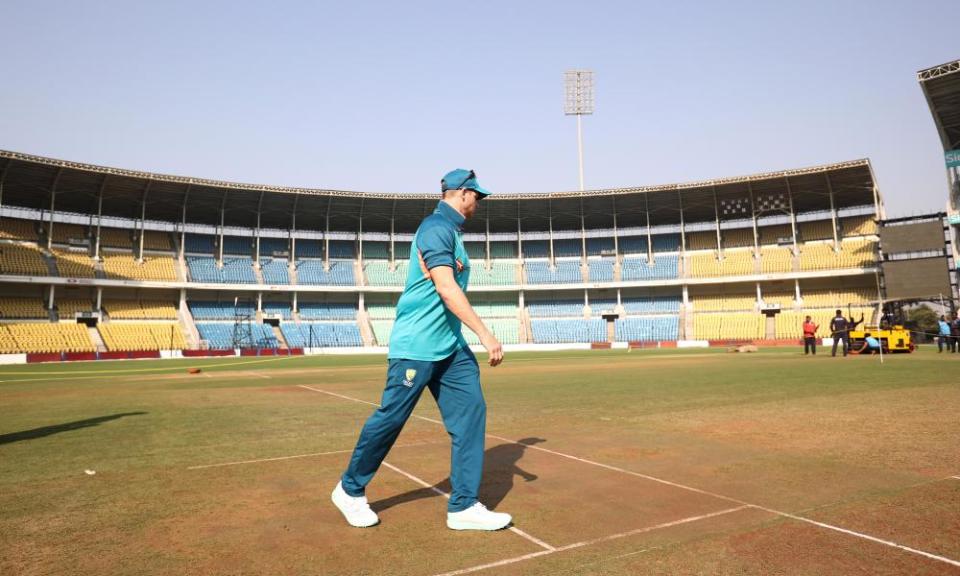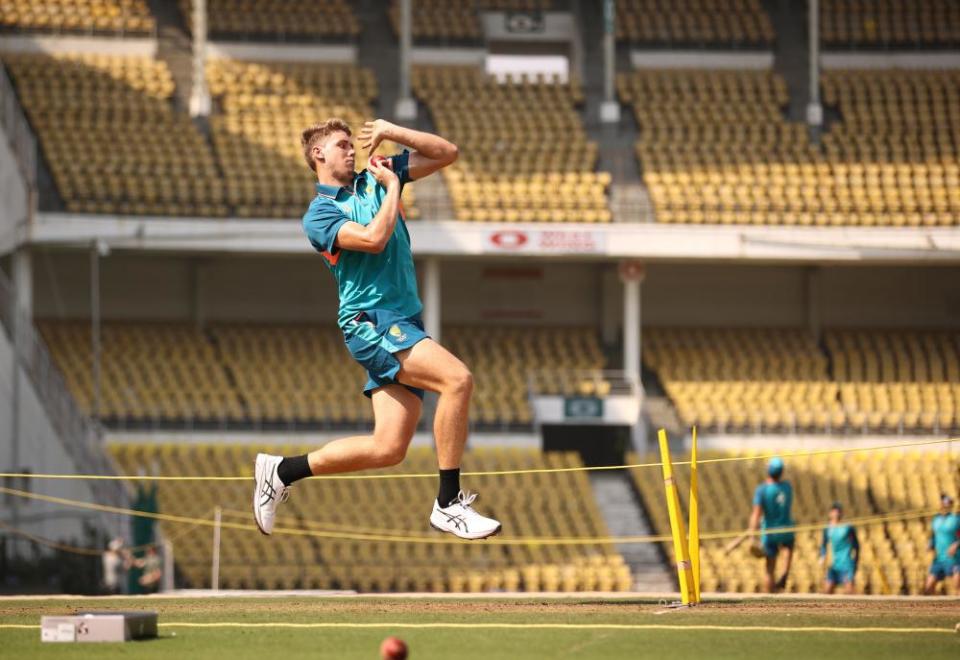Australia gear up for pitch battle with spin again looming as king in India

India. Spin city. You know the drill. A visiting team rocks up, especially one from outside Asia, and gets greeted by tracks that turn as viciously as King Lear’s kids. The rule of thumb says that’s fair enough – teams are free to play in the conditions that suit them most, like Australia’s bouncy pitches or England’s seamers.
It does feel a little different when the curators play horticultural Frankenstein, stitching together disparate parts to become an incongruous whole. With the first Test in the Border-Gavaskar series about to start on Thursday, it’s hard to draw any other conclusion from the images of the Nagpur ground staff watering the pitch outside the off stump for right-handed batters, of which India will probably play nine, while leaving it bare and dry outside the off stump for left-handers, of which Australia could play seven.
Related: Aaron Finch: Australia’s T20 captain retires from international cricket
More than arguments about rights and wrongs, the approach seems redundant. If influencing the result is indeed the intention, and if it works, it will only exacerbate a gulf between the teams that probably doesn’t need any widening. Australia cannot compete with India for quality of spin, whatever surface.
Leading the way for the home team will be one of the great spin pairings. Ravichandran Ashwin is one wicket shy of 450 in Tests, and is already second on India’s all-time list. Ravindra Jadeja is eight short of 250. Right-arm and left-arm finger spinners of wildly varying styles, Ashwin loops the ball to tease players before foxing them with a huge bag of tricks, while Jadeja spears it through in overs that typically take 70 seconds apiece and relies on natural variation. In matches together they have taken 431 wickets, which is exactly one metric Richard Hadlee.
Then you throw in their third option, Axar Patel, who has only been chosen for eight Tests in the past couple of years but five times has taken five wickets in an innings. Also a left-arm orthodox, he is nonetheless a different proposition to Jadeja given his extra height that lets him drive the ball into the surface, getting unpredictable bounce when that surface gives way. Left-arm wrist spinner Kuldeep Yadav is in the squad, but unlikely to be turned to given the control and parsimony that the finger-spin brigade brings to the middle.
For the visitors, only Nathan Lyon can match the standard of any of India’s four. The Australian off-spinner has learned his trade in Asia since his debut in Sri Lanka all the way back in 2011, and cracked the code in India in 2017 with his career-best 8-50 that should have been rewarded with a win in Bengaluru. Currently 11 wickets ahead of Ashwin on 460, the premier pair could be locked in a series-long battle for eighth spot on the all-time list.

What Lyon won’t have is the quality of support. Australia hope that Ashton Agar can play an Axar Patel role as a tall left-armer, but Agar’s five Tests have yielded nine wickets, where Axar has 47 in eight. Mitchell Swepson was the second spinner in Sri Lanka and Pakistan last year, but struggled for impact and Indian teams at home traditionally devour leg-spinners whole. There are hints that a spot will go to uncapped Victorian off-spinner Todd Murphy, given his father is flying to Nagpur at the last minute in time for the start of the match.
“I think he’d be as prepared as he could be,” said Australian captain Pat Cummins of Murphy the day before the match. “He’s been bowling beautifully in the nets over here. He’s stared really well for Victoria in first-class cricket. If he got the nod, he’s got Nathan Lyon down the other end that he can work with. He’s ready – everyone in the squad here has had really good preparation. Whoever we pick is 100% ready to go.”
Cummins knows who he is going to pick, but won’t let on until the toss. Cameron Green’s failure to recover from his broken finger means that there will be no fast-bowling all-rounder, an absence that will make it much less likely for Australia to choose three spinners. The other consideration is whether to respond to India’s ploy against left-handers by choosing the right-handed Peter Handscomb to bat at six instead of Matthew Renshaw.
“Potentially,” he said of the switch. “The amount of traffic from right-arm quick bowlers, even the offies, is right outside where the left-handers are batting. Traditionally sometimes it can be hard for the lefties.”
But then, perhaps letting the other team affect your own approach before the match has even begun is a recipe to outthinking yourself. As the incumbent in the team during the build-up, Renshaw has looked composed against spin, and that is the task for Australia against an all-star opposition. Dry, rolled, watered, none of of the variations of surface can change the fundamentals of that.

 Yahoo Sport
Yahoo Sport 





































